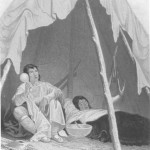Weekly Wrap Volume 32
 Why Cashews are Not Sold to Consumers in Their Shells and Why Pistachios Used to Be Dyed Red
Why Cashews are Not Sold to Consumers in Their Shells and Why Pistachios Used to Be Dyed Red
Cashews are a member of the same family as poison ivy, Anacardiaceae. Like poison ivy and many other members of the family, part of the cashew plant contains an oily chemical called urushiol, which is a strong irritant for most people and can even be fatal for some if ingested. In cashews, the urushiol is found not only in the leaves, but also in a layer of oil between the shell and the cashew seed. Needless to say… (more)
 Why Do Asian Nations Use Chopsticks?
Why Do Asian Nations Use Chopsticks?
Created roughly 4,000-5,000 years ago in China, the earliest versions of something like chopsticks were used for cooking (they’re perfect for reaching into pots full of hot water or oil) and were most likely made from twigs. While it’s difficult to nail down a firm date, it would seem it wasn’t until around 500-400 AD that they began being used as table utensils. One factor that contributed to this switch was a population boom across the country. Consequently, resources, particularly for cooking, became incredibly scarce. As a result, people began cutting their food into tiny pieces so it would cook faster. The bite sized morsels rendered table knives obsolete, as there was… (more)
 Why Native Americans Didn’t Wipe Out Europeans With Diseases
Why Native Americans Didn’t Wipe Out Europeans With Diseases
While estimates vary, approximately 20 million people are believed to have lived in the Americas shortly before Europeans arrived. Around 95% of them were killed by European diseases. So why didn’t 19 out of 20 Europeans die from Native American diseases? The short answer is that Europeans simply had more robust immune systems. Several factors contributed to this: first, Europeans had been the caretakers of domestic animals for thousands of years, and had over time grown (somewhat) immune to the common diseases that accompanied the domestication of such food sources. Native Americans, on the other hand, were… (more)
 How the Sun Burns Your Skin and How Sunscreen Prevents This
How the Sun Burns Your Skin and How Sunscreen Prevents This
Every summer we slather layers of sunscreen with the highest SPF we can find, and bravely venture outside hoping our slimy cloak will shield us from the sun’s death rays. So how does this work? To start off, what is a sunburn? In the medical world, a sunburn is known as erythema. Basically meaning the redness of skin caused by dilatation and congestion of the capillaries, and is often a sign of inflammation or infection. Several things can cause your skins capillaries to become inflamed. Things like infection, allergies, mercury toxicity, tweezing or pulling on your hair follicles, and of course, the sun’s… (more)
 That Time the Inventor of Whac-A-Mole Accidentally Blew Up His Warehouse
That Time the Inventor of Whac-A-Mole Accidentally Blew Up His Warehouse
It was lunch time on a muggy late September day in 2013 when an explosion shook downtown Orlando, Florida. A warehouse on west Jefferson street was the casualty. Police cars, ambulances, and fire trucks were already on their way by the time Tim Roth, a good Samaritan, was on the scene. As he searched through the rubble and debris for injured humans, what he found was something else entirely. As described by the Orlando Sentinel in the next day’s paper, “among the knocked-down suits of armor, animatronics, old arcade games, clown suits and broken lighted signs (it was) as if (Roth) were in the Joker’s lair.” Fortunately, no humans were injured in the blast, but a wide collection of electronic amusements were destroyed beyond repair… (more)
Bonus Quick Facts:
- Actor Jimmy Stewart was also a two star General in the U.S. military, serving from 1941 to 1968. The full list of military awards achieved by Stewart are: 2 Distinguished Flying Crosses, 4 Air Medals, 1 Army Commendation Medal, 1 Armed Forces Reserve Medal, 1 Presidential Medal of Freedom, and 1 French Croix de Guerre with Palm. He earned most of these medals during WWII where he participated in numerous missions flying into Nazi occupied Europe in his B-24, flying in the lead position of his group in order to inspire the soldiers under him.
- Incidentally in 1940, when Stewart was drafted into the United States Army, he ended up being rejected due to being five pounds under the required weight, given his height (at the time he weighed 143 pounds). Not to be dissuaded, Stewart then sought out the help of Don Loomis, who was known to be able to help people add or subtract pounds rapidly. Once he had gained a little weight, he enlisted with the Army Air Corps in March of 1941 and was eventually accepted, once he convinced the enlisting officer to re-run the tests.
- R.S.V.P. stands for Répondez S’il Vous Plaît, which translates roughly as “please reply” or “reply if it pleases you”.
- The Bluetooth standard is named after a 10th Century Scandinavian King. The man was Harald I of Denmark. “Bluetooth” is the English translation of “Blåtand”, which was an epithet of Harald I (Harald Blåtand Gormsson). Legend has it, he received this name due to being extremely fond of blueberries and consuming them so regularly and in such volume that they stained his teeth blue.
- Keanu Reeves’ first name is pronounced “Kay-ah-noo”, not “Key-ah-Noo”. That isn’t the only misconception surrounding his name. The name itself means “the coolness”, but is often incorrectly said to mean “cool breeze over the mountains”. Reeves’ was named after his uncle Henry Keanu Reeves. In Keanu Reeves’ early days in Hollywood, his agent thought his name was too exotic and in his early films he is often credited as K.C. Reeves (his middle name is Charles).
- A coffee “bean” is not actually a bean, rather it is a seed. Now I know you are saying to yourself right now, “Aren’t beans seeds and seeds beans?” Nope. In fact, though beans are always seeds, seeds are not always beans. A bean is just one kind of a seed. Specifically, it is a name for seeds of the family Fabaceae (also known as Leguminosae) of which the coffee plant is not a member; thus, coffee “beans” are not actually beans.
- The medical term for the irrational fear of being buried alive is called Taphophobia (also occasionally spelled Tephephobia). Taphophobia derives from the Greek “taphos” meaning “grave.”
- All 43,252,003,274,489,856,000 positions of a standard Rubik’s Cube can be solved in 20 moves or less. This was proved in July of 2010 by Tomas Rokicki, Herbert Kociemba, Morley Davidson, and John Dethridge who used 35 CPU years worth of computing time, donated by Google, to determine this.
- One “CPU Year” is typically referred to as the work potential able to be done by one Giga-FLOP machine in one year. For those who aren’t familiar, a “FLOP” just means “Floating Point Operations Per Second”. Thus, a one FLOP machine can do one operation per second. A one Giga-FLOP machine, usually abbreviated as a GFLOP, can do one billion operations per second. So to prove the above, the researchers used 35 CPU Years or around 1,103,760,000,000,000,000 operations, which, you’ll note, is less than the number of possible Rubik’s Cube positions. For more on how exactly they managed to reduce the problem so drastically to be able to do it in so “few” operations, go to their website here.
Other Interesting Stuff:
 TodayIFoundOut and Neatorama Giveaway
TodayIFoundOut and Neatorama Giveaway
We’ve partnered up with our good friends over at the ever popular Neatorama to hold a contest with super awesome prizes and a bunch of easy ways to enter. The Grand Prize winner will receive a $100 Amazon gift card, a crazy cool Captain America Mystery Box (pictured here), and one t-shirt from each of Neatorama’s and TodayIFoundOut’s shops. Runner ups can win… (more)
 The Canadian Man Who Single-Handedly Liberated the City of Zwolle in the Netherlands from German Occupation
The Canadian Man Who Single-Handedly Liberated the City of Zwolle in the Netherlands from German Occupation
Leo Major was a French Canadian man born in 1921. He probably didn’t think he was going to be more of a hero than the average soldier when he joined up with the Canadian Army at the start of World War II—supposedly he simply joined up because he wanted to show his father, with whom he had a shaky relationship, that he could do something to be proud of. Major started his overseas tour in 1941, serving in Le Regiment de la Chaudiere. On D-Day, he was wounded by a grenade, resulting in the partial loss of vision in his left eye. Major refused to be sent home, arguing that he only needed one good eye to sight a rifle. He was placed in the scout platoon… (more)
In its various incarnations, the F-word can be a noun, verb, adjective, and even an infix. The Crescent wrench of the English language, the F-bomb has been adding emphasis, vulgarity and spice to our conversations for longer than anyone can remember. Because it is the type of word that “wasn’t written in the kind of texts that have survived from Old English and Middle English,” it is difficult to trace it’s origins, although experts believe it is “ancient.” Some claim that a man went… (more)
 Julia Child was a Top Secret Research Assistant for the Predecessor of the CIA, the Office of Strategic Services
Julia Child was a Top Secret Research Assistant for the Predecessor of the CIA, the Office of Strategic Services
After graduating from college with a degree in English, Julia Child, then named Julia McWilliams, worked in the advertising department for W. & J. Sloane in New York City as a clerk. She later moved to California and continued to work in advertising in more or less the same position. When the U.S. entered WWII, Child tried to volunteer for the Navy’s Women Accepted for Volunteer Emergency Service (WAVES), but was rejected due to her height (6 feet 2 inches, which was 2 inches above the maximum for WAVES). This turned out to be a good thing as, had she been accepted to WAVES, she never would have met her husband… (more)
This Week’s Podcast Episodes:
- Podcast Episode #71: The Largest Item on a Menu
- Podcast Episode #72: Mozart and the Alphabet Song
- Podcast Episode #73: The Scandalous Original Version of Sleeping Beauty
- Podcast Episode #74: The Reason Split Infinitives Were For a Time Considered Incorrect Grammatically
- Podcast Episode #75: The Woman Who Every Human Alive is Genetically Related To
| Share the Knowledge! |
|






THE TITLE SAYS “WEEKLY WRAPE.” I highly doubt this was intentional so I figured I’d let you know.
@Pete: Ha, that’s weird 🙂